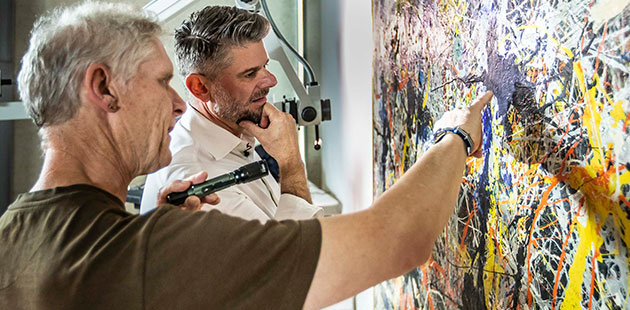 The painting that launched a love affair with art for many Australians – Jackson Pollock’s Blue poles 1952 – has gone under the microscope for its most comprehensive conservation project to date.
The painting that launched a love affair with art for many Australians – Jackson Pollock’s Blue poles 1952 – has gone under the microscope for its most comprehensive conservation project to date.
Rarely off display since the National Gallery of Australia opened in 1982, the pandemic closure provided an unparalleled opportunity for the first in-depth research, analysis, and major conservation treatment of Blue poles since its acquisition in 1973. Long planned, the major study of the painting had not previously been possible because the work is always on display.
National Gallery Director Nick Mitzevich said it was the most significant conservation work ever on the painting that continues to transfix the nation. “It was the first time we could spend an extended amount of time exploring the materiality, conserving, and cleaning the work,” he said. “This is the most important work we’ve done on this painting and I hope people come with us on the journey to explore this work of art.”
David Wise, the National Gallery of Australia’s Senior Paintings Conservator, has the enviable task of interrogating Blue poles in situ to discover the secrets beneath the layers of paint, using surface microscopes, ultraviolet and infrared light, and other analytical techniques to uncover surprises hidden to the naked eye.
“This extended period without visitors really allowed us to get to grips with the surface and look at this painting in depth using all the tools available to us,” said Mr Wise. “We’re hoping, through this analysis and research, to find out exactly what is going on with this painting as it moves towards its 70th birthday.”
“There has been conservation work carried out in the past and there have been some questions asked and answered but never with this breadth. We have never had this opportunity to work with this painting for weeks on end. It’s a fantastic opportunity.”
In 2022, Blue poles, a favourite among visitors, will celebrate its 70th birthday, while the National Gallery of Australia will mark the 40th anniversary of its opening. The Blue poles project will encourage a new generation to discover the painting and others rediscover a much-loved work of art.
Alongside the painstaking conservation work, a team at the National Gallery delved into the institution’s extensive research library to develop a rich living archive of content for a new microsite, Jackson Pollock’s Blue poles: Action / Reaction – a site that will continue to be updated in the lead up to the Gallery’s anniversary. The site explores all facets of Pollock’s impact on culture including art, music, food, and fashion.
Blue poles: Action / Reaction features footage of the conservation project, recipes from Pollock’s cookbook, an interview with the artist’s relatives, photo galleries and archival footage, podcasts, vintage posters and ephemera that tell the story of Blue poles, Jackson Pollock, the work’s connection to the National Gallery and its place in Australian society.
In 1973, there was an outcry when the then Prime Minister, the late Gough Whitlam, authorised the National Gallery’s founding director James Mollison to purchase Blue poles for $1.3 million – at the time the highest price paid for a work of contemporary American art.
“It was a big deal, the National Gallery had not opened and people had very little sense of how the building and the collection would be,” said Senior Curator International Painting and Sculpture Lucina Ward. “So, the whole idea that a large work, an abstract work, a work by an American artist should become such a key early purchase in the collection, was really quite shocking.”
Over time, Blue poles has become embedded in the psyche of the nation and a must-see destination work for Australians and international visitors. For thousands of Australian students, it has become a cultural rite of passage during school tours to the national capital.
Mr Mitzevich remembers his first encounter with Blue poles as an 18-year old: “This picture was larger than life. I thought I knew a lot about Jackson Pollock, then I stood in front of the work and everything changed. The picture came alive and jumped off the walls,” he said.
As the National Gallery’s 40th birthday approaches, people are invited to share their memories of Blue poles through a #MyBluepoles social media campaign on Instagram, Facebook, and Twitter.
From 8 July 2020, visitors to the National Gallery can see conservator David Wise working on Blue poles every Wednesday from 1.30 – 2.30pm. Thursday Art Talk | Jackson Pollock’s Blue poles | 9 July 2020, 12.45 – 1.30pm | Watch Live stream on Facebook.
For more information, visit: www.nga.gov.au or www.bluepoles.nga.gov.au for details.
Image: National Gallery of Australia’s Director Nick Mitzevich (right) and Senior Conservator of Paintings, David Wise (left) analysing Jackson Pollock’s Blue poles 1952, © Pollock-Krasner Foundation. ARS/Copyright Agency
